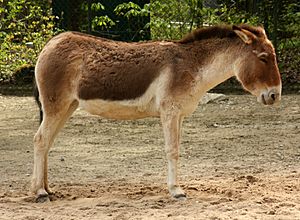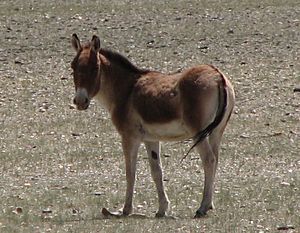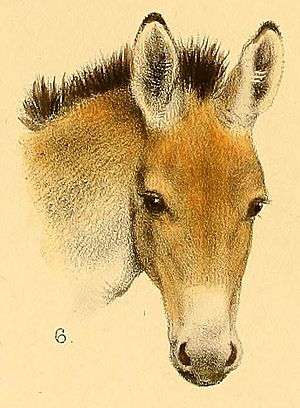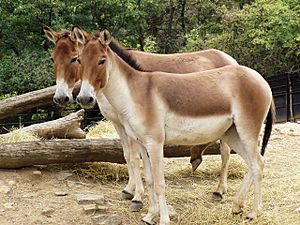Kiang facts for kids
Quick facts for kids Kiang |
|
|---|---|
 |
|
| Conservation status | |
| Scientific classification | |
| Genus: |
Equus
|
| Species: |
kiang
|
 |
|
| Range map | |
The kiang (Equus kiang) is the largest type of wild ass. It lives on the Tibetan Plateau in Asia. You can find it in grassy and mountainous areas. Its home is mainly in the plains of the Tibetan Plateau, Ladakh in India, and northern Nepal near the Tibetan border. People also call it the Tibetan wild ass, khyang, or gorkhar. Some stories about the kiang even helped inspire the idea of the unicorn!
Contents
What Does a Kiang Look Like?
Kiangs are the biggest wild asses. They stand about 132 to 142 centimeters (about 4.3 to 4.6 feet) tall at the shoulder. Their bodies are about 182 to 214 centimeters (about 6 to 7 feet) long. Their tails are 32 to 45 centimeters (about 1 to 1.5 feet) long.
Male kiangs are a bit heavier than females. Males weigh 350 to 400 kilograms (770 to 880 pounds). Females weigh 250 to 300 kilograms (550 to 660 pounds). They have a large head with a rounded nose. Their mane, the hair on their neck, stands up and is short.
Their fur is a rich chestnut color. It's darker brown in winter and a shiny reddish-brown in late summer. This is when they shed their thick winter coat. Their legs, belly, nose tip, and inside of their ears are white. A wide, dark brown stripe runs down their back from their mane to their tail. The tail ends in a tuft of blackish-brown hair.
Where Do Kiangs Live?

Kiangs live on the Tibetan Plateau. This area is between the Himalayas in the south and the Kunlun Mountains in the north. Most kiangs live in China. However, about 2,500 to 3,000 kiangs also live in Ladakh and Sikkim in India. Smaller groups are found along the northern border of Nepal.
Scientists recognize three types of kiangs:
- E. k. kiang — the western kiang, found in Tibet, Ladakh, and southwestern Xinjiang.
- E. k. holdereri — the eastern kiang, found in Qinghai and southeastern Xinjiang.
- E. k. polyodon — the southern kiang, found in southern Tibet and near the Nepalese border.
The eastern kiang is the largest type, and the southern kiang is the smallest. The western kiang is a bit smaller than the eastern one and has darker fur. However, we don't have enough genetic proof to say these are truly different types. They might just be slight variations across their habitat.
Kiangs live in high-altitude grasslands and open plains. They prefer flat areas, wide valleys, and low hills. These places have lots of grasses and other low plants for them to eat. Open areas also help them see predators and run away easily.
How Do Kiangs Behave?
Kiangs are herbivores, meaning they eat plants. They mostly eat grasses and sedges. When there isn't much grass, like in winter, they might eat shrubs, herbs, or even roots. Water is scarce on the Tibetan Plateau. Kiangs likely get most of their water from the plants they eat. They might also eat snow in winter.
The only main predator of kiangs, besides humans, is the Himalayan Wolf. Kiangs protect themselves by forming a circle. They put their heads down and kick out fiercely. Because of this, wolves usually try to attack kiangs that have wandered away from the group.
Kiangs sometimes gather in large groups of hundreds of animals. But these groups don't last forever. They are temporary gatherings of either young males or mothers with their foals. Older male kiangs usually live alone. They protect an area of about 0.5 to 5 square kilometers (0.2 to 2 square miles). They also try to control any local groups of females.
Territorial males can become aggressive towards other kiangs that enter their area. They might kick and bite them. More often, they chase them away after a warning display. This display involves flattening their ears and making loud braying sounds.
Kiang Life Cycle and Reproduction
Kiangs mate between late July and late August. During this time, older males follow females. They trot around them and then chase them before mating. A female kiang gives birth to one foal after being pregnant for seven to 12 months. Females can get pregnant again soon after giving birth. However, it's more common for them to have a foal every other year.
Newborn foals can weigh up to 35 kilograms (77 pounds). They are able to walk within a few hours of being born. We don't know exactly when kiangs become old enough to have babies. It's probably around three or four years old, similar to their close relatives, the onagers. Kiangs can live for up to 20 years in the wild.
Stories from Travelers
Some historians believe that old stories about kiangs helped inspire the idea of the unicorn. The ancient Greek doctor Ctesias first described the unicorn in his book Indika.
Ekai Kawaguchi, a Japanese monk, traveled in Tibet from 1900 to 1902. He wrote about the khyang (kiang): "The khyang is the name Tibetans give to their wild horse of the northern plains. It's actually a type of ass, as big as a large Japanese horse. It's reddish-brown with black hair on its back and a black mane. Its belly is white. It looks like a normal horse, except for its tufted tail. It's a strong and incredibly fast animal. You never see just one; they are always in groups of two or three, or even herds of sixty or seventy.
It has a strange habit of turning around when it sees a person. Even from over a mile away, it will start turning around at every short distance as it gets closer. After each turn, it stops to look at the person over its own back, like a fox. Eventually, it comes quite close. When it's very near, it looks scared. At the slightest thing, it will turn and dash away. But it only stops to look back. When you think it has run far away, you find it has circled back very close. It seems to be silently watching the stranger from behind. Overall, it's an animal with very odd habits."
Thubten Jigme Norbu, the older brother of the 14th Dalai Lama, wrote about his trip in 1950: "The kyangs, or wild asses, live in smaller groups. Each group is led by a male, who controls 10 to 50 females. I was amazed by how noble these animals looked, especially their beautiful head and neck. Their fur is light brown on their back and whitish on their belly. Their long, thin tails are almost black. This coloring helps them blend in with their surroundings. They look wonderfully graceful when they dart across the plains like arrows. Their heads are stretched out, and their tails stream behind them in the wind.
Their mating season is in the autumn. At this time, the males are most aggressive as they protect their groups of females. The fiercest and most brutal fights happen then between the lead male and other males from different herds. After the battle, the winner, bloody and bruised from bites and kicks, leads the females away in a wild gallop across the plains.
We often saw thousands of kyangs spread over the hillsides. They would look curiously at our group. Sometimes they would even surround us, but they always kept some distance."
Images for kids
See also
 In Spanish: Kiang para niños
In Spanish: Kiang para niños





